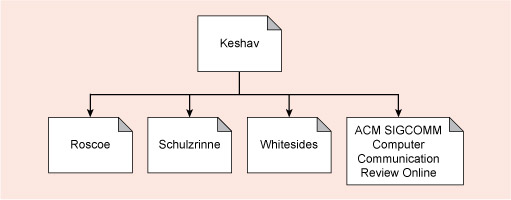8.1.8 Relating
As you will realise from your professional practice, there are many contributors to any area of research or practice. The relationship between contributors is complex (sometimes circular), extends in time and can be affected by politics. At this point, however, we will look only at indicators of dependence as revealed through a bibliography.
The bibliography of a paper indicates the parts of the context of the paper that have been influential in its writing. Keshav’s bibliography consists of four websites. Such a source citation is appropriate for his paper, but actually is not typical of an academic paper. Even so, we can plot the relationship between Keshav’s paper and the material it cites as in Figure 5.
Activity 22
Add each element in Keshav’s bibliography to your BDMS.
Discussion
You may have noticed that the Roscoe website itself lists as a resource the Keshav paper that you have just analysed. That means that if we were to extend Figure 5 there would be a loop in it. You would not often find this phenomenon in typical archival research articles because a paper is normally printed and once printed is unchangeable. Online resources such as Roscoe’s can of course be updated, so can incorporate references to other resources that were created after the original item.
We added five entries to our BDMS, corresponding to the five references. For each we set the ‘Referenced by’ field to ‘Keshav2007How’ as suggested by the diagram we drew.
Now complete Activity 23, which returns you to the discovery stage.
Activity 23
Consider a few topics that interest you in the area of software development. Focus on one of them, and using a search method of your choice, find three research articles that are relevant to your interests. Run through Keshav’s workflow (first pass only) for each item found and if you think the item is sufficiently interesting, create an entry in your BDMS. Record your notes on each.
Do you think that you’d conduct a second (or third) pass on any paper that you found?

